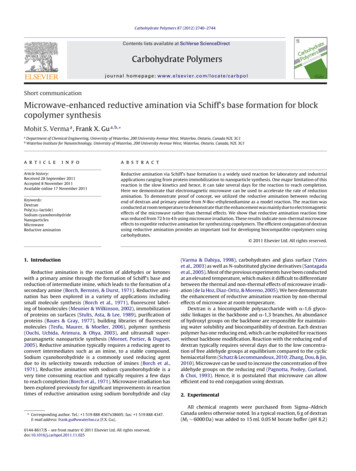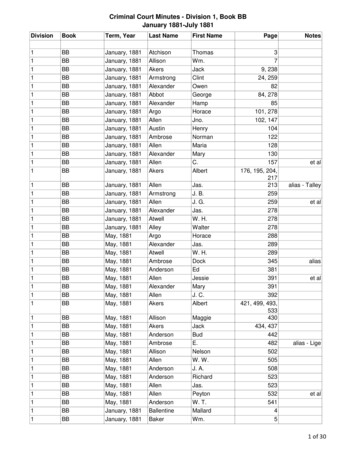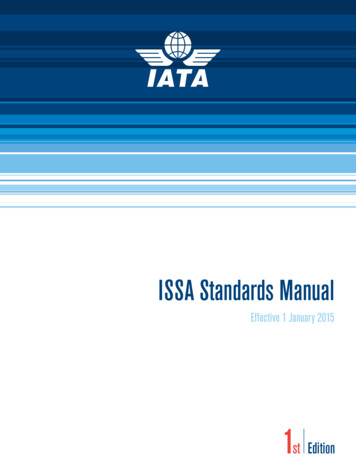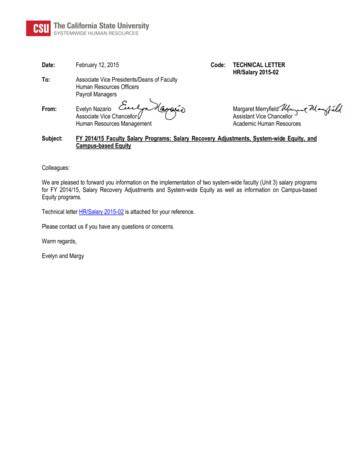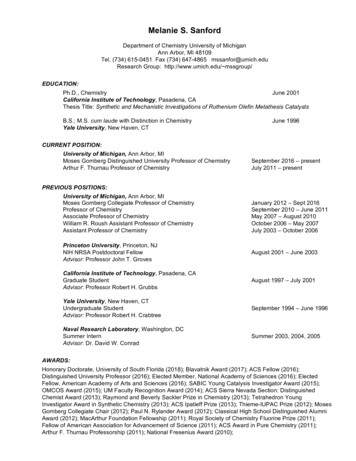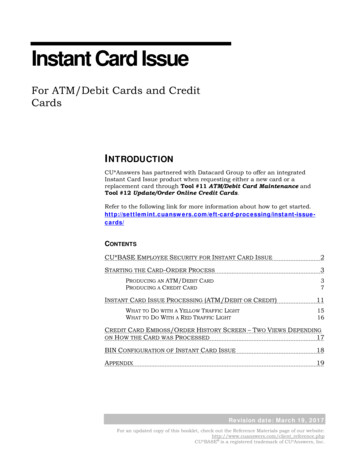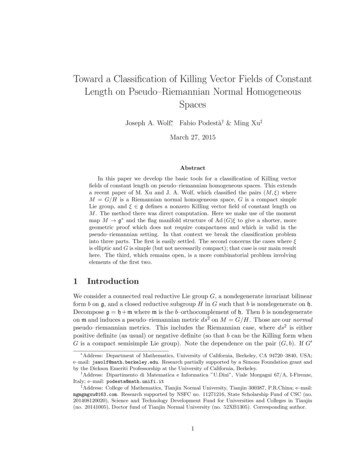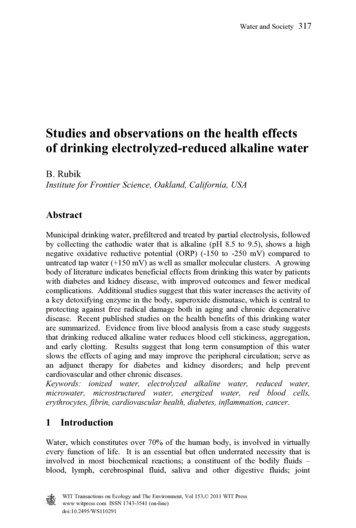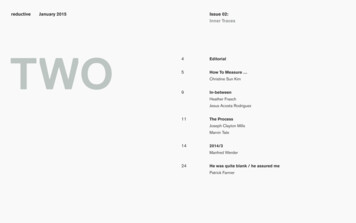
Transcription
reductiveJanuary 2015TWOIssue 02:Inner Traces4Editorial5How To Measure Christine Sun Kim9In-betweenHeather FraschJesus Acosta Rodriguez11The ProcessJoseph Clayton MillsMarvin Tate142014/3Manfred Werder24He was quite blank / he assured mePatrick Farmer
Inner TracesTWO
EditorialReductive journal TWO presents the theme inner traces, whichenergy of abandoned spaces, by documenting the transitional de-shapes a framework for five contributions from Christine Sun Kim,cay between structures and environmental forces. The project trac-Heather Frasch, Joseph Clayton Mills, Manfred Werder and Patrickes a connection between outside spaces and the inner resonancesFarmer. inner traces refers to the internal counterpoint embeddedof the audience. The Process, a collaboration between Josephthroughout the text-sounds, as found in these contributions. TheClayton Mills and Marvin Tate, weaves together a fragmented anddiverse approaches observe silent traces of text-sound inter-perme-improvisatorial audio diary, into a fixed form that still pulsates withations. Text and sound co-arise in listening, reading, experiencing,life. The stories become retold, initially from the poet, reinterpretedperceiving, receiving etc. The use of language and audio materialby the composer, and finally residing in the memory of the listener.qualifies music as a particular environmental experience that chal-In Patrick Farmer’s He was quite blank / he assured me, extractedlenges the inner listening.from the reading, the poetic writing furthers notions of music, mem-Christine Sun Kim’s work articulates her understanding of mu-ory and place. His discerningly detailed story offers aural imagina-sical symbols in a drawing series that investigates the dynamicstions. The character, ‘in an attempt to avoid silence’, talks, writesof loudness and quietness. Sun Kim’s work represents the impos-and hears, and all memories are simultaneously informed as musicsibility of absolute silence and embodies the recognition of soundin a reading response.perception. Sun Kim’s approach is complemented by ManfredThese works manifest awareness. How do we perceive text thatWerder’s contribution 2014/3, a series of text scores which pro-listens to sound? How do we listen to texts that are not spoken?vide a ‘field’ for listening. His texts are ‘found’ objects that provokeHow is sound animated from text that intends silence? The ques-thoughts or ideas, which are performed by various artists in non-tions continue and observe further creation.musical and musical situations. Heather Frasch and Jesus Acosta’ssound and image collaboration In-Between, examines the residualRyoko Akama / Heather FraschEditorial3
Contactreductivejournal@gmail.comEditorsRyoko Akama ryokoakama.comHeather Frasch heatherfrasch.netDaniel del Río cimaural.net/danieldelrioContributorsPatrick Farmer patrickfarmer.orgHeather Frasch heatherfrasch.wordpress.comChristine Sun Kim christinesunkim.comJoseph Clayton Mills josephcmills.comJesus Acosta Rodriguez cargocollective.com/jesusacostaMarvin Tate marvintate.bandcamp.comManfred Werder manfred-werder.blogspot.co.ukDesignerVasco Alves vascoalves.infoPublisherreductive reductivemusic.comPlease do not reproduce content without prior permission from contributors.Credits4
Christine Sun KimHow To Measure I was born deaf in both ears; 95 decibels in my right ear andppp pianissimo; the number of p’s is unlimited.115 decibels in my left. Sound and silence have a mathematical side,pp pianissimo; the more p’s the quieter the performance gets.which I’ve never been able to fully grasp - just like taxes. In an attemptp piano; a note that indicates a tone-down.to confront this aspect, I created a series of drawing pieces calledmp mezzo piano; half piano, used as a calibration point.How to measure., which are based on a collection of lists of mymf mezzo forte; half forte, used as a calibration point.own personal interpretations of ways to measure sound. Such listsf forte; a note to indicate a tone-up.include: how to measure pauses, loudness and quietness in sound.ff fortissimo; exactly the opposite of pianissimo.One such piece, entitled How to Measure Pauses is about how afff fortissimo; the number of f’s is unlimited.pause would spatially travel from one note to another, dependingon your sense of time. In another example, I was influenced by theHow to Measure Quietness is my current and closest definitionsimilarities and subtle differences between the lists for loudness andof what people call “silence”, which is a highly subjective, overloadedquietness.and murky term. People use sound to shape silence and vice versa.I employ musical symbols in my drawings as a way to effectivelyI inhabited this concept without questioning it whilst growing up.engage with diverse and broad audiences. I do not consider myself aHowever, now as an artist, I’m in the progress of re-framing silence,musician but rather an artist who hijacks music formats to communicatewhich I often perceive as a kind of sound and full of noises. Hence,ideas. The musical symbols that describe the state of sound/silencethe quietness in my work replaces silence.in the drawings are:How To Measure .5
One PauseTwo PausesHow To Measure PausesHow To Measure .6
How to Measure LoudnessHow To Measure .7
How to Measure QuitenessHow To Measure .8
Heather Frasch & Jesus Acosta RodriguezIn-betweenOrganic movement, the raw energy of the earth, growing constantly, seemingly chaotic to the human eye. Structures created to5’04” 80.5MBkeep these forces at bay. Cold and immutable, they are clean andquiet receptacles of supreme efficiency. Then, forgotten – abandoned– but not destroyed. No longer kept alive by their inhabitants, they“In-Between” is a collaborative project by Jesus Acosta Rodri-began to fade like shadows. These structures continue to vibrate inguez and Heather Frasch. They both, one through images and thethe emptiness. Their quiet resonance is heard in the stillness.other with sound, try to explore these “in- between” moments, thesePeacefully moving. The powerful force of nature beginning tocombined energies that resonates in different spaces and times. Theinfiltrate the decay. Movement that goes unnoticed. Yet, its unhur-final artistic project resonates in the personal inner spaces of thoseried pulsations continue, slowly permeating the space, and growingthat watch and listen. It is not there, and no longer here, but some-stronger inch by inch, day by day and year by year. These two ener-where “in-between.”gies, one in decay and the other invading, mix and resonate together,creating something new, a dance between what is dying and whatthrives in its place.In-between9
In-between10
Joseph Clayton Mills & Marvin TateThe ProcessThe Process is an excerpt from an ongoing collaboration between myself and Marvin Tate, who is a poet, singer, artist, and longtime figure on Chicago’s cultural scene. Despite having many friendsand acquaintances in common, Marvin and I didn’t actually meet oneanother until the summer of 2013. I saw him perform at a local musicvenue, and the intimacy and immediacy of his performance that night— part storytelling, part poetry, and part song—made a strong impression on me.A few days after that initial meeting, Marvin called me to discussthe possibility of collaborating. I had long been interested in workingconnection to Chicago, its neighborhoods, and its history—musical,at the intersection of text and sound but had never directly collabo-social, and political—was another important area of overlap.rated with a poet; Marvin had often combined his poetry and spokenSoon after we began discussing the possibility of working to-word performances with traditional song structure, but he was eagergether, Marvin handed me a cheap, hand-held digital recorder, say-to explore something more experimental and challenging. We wereing “This is my mind; listen to it, see what you think.” He told me thatboth curious to see what we’d be able to come up with (“let’s seehe had carried the recorder with him everywhere for the past severalwhat’s behind door number three,” as Marvin put it). The distanceyears, always recording and never erasing. When I listened to it, I dis-between our respective musical backgrounds seemed as if it wouldcovered that it held hours and hours of material: fragmentary ideas forpose an obstacle to working together, but we quickly confirmed thatpoems and songs, conversations with his wife, arguments betweenour fundamental assumptions and approaches were very much instudents in his classroom, birthday party sing-a-longs, band rehears-line with one another. Moreover, for each of us, a shared sense ofals, memories, and jokes. It was an encyclopedic document, but oneThe Process11
without any order or pattern other than the chronology of Marvin’swith Marvin’s recordings, in turn, raised the possibility of engaginglife. It was a palimpsest in which moments recorded on impulse (andwith a broader field of social and historical signification than I’d beensometimes by accident) were juxtaposed with notes and sketchesable to address before, incorporating issues of race, class, and vio-that would evolve, over time, from inspiration into finished poems.lence that are rarely explicitly touched on in experimental music, butSome snippets of sound would last only a second or two, whereaswhich are an everyday reality in Chicago.other recordings would stretch on for ten or fifteen minutes. Some-This archive, constantly revised, reconfigured, and supplemented,times the context was obvious, but it was just as often mysterious andhas formed the raw material for an ongoing series of performances inimpenetrable. Listening to this material was like trying to assemble anwhich Marvin and I have improvised with and within a series of texts:auditory jigsaw puzzle from which half of the pieces were missing.the lines of his poems, the story of his life, and the fragmentary record-This document — this dense, fractured audio text—would becomeings through which he negotiates the transformation of one into thethe source of our future collaboration. My own initial role was merelyother. In those performances, my goal is often simply to allow Marvinto listen attentively; then, having listened to this mass of material asto listen to himself; to interrupt him with his own memories and con-closely as possible, I tried to draw out the threads of images andfront him with the sound of his own words. His recordings becomeideas that ran through it. In editing and rearranging Marvin’s wordsa text to be read and reread together in performance, just as certainand voice, framing and contrasting his sounds with my own, I workedpoints in his life become, through memory and language, the subjectto give form to what was a largely inchoate body of material. Workingof constant revisiting and re-interrogation. In The Process, however,the intention is to distill those improvisatory moments into a fixed aesthetic form that nonetheless retains the texture of lived experience.Our collaboration hinges in large part on Marvin’s awarenessof the transformative capacity of language. In his writing and performance, his biography is refracted through a series of charactersand adopted voices in which the lines between history, memory, andimagination dissolve. He opens himself to a similar process when heentrusts his stories to me to retell. He understands how one can takepossession of a story—his own or another’s—and live through it, orThe Process12
hide inside of it. One of the stories told in The Process is of how, ona schoolyard playground, Marvin made the Gwendolyn Brooks poem14’18” 151.4MB“We Real Cool” his own and, through that first experience with poetry, opened up the path that he is still on. He understands the powerThe Processof turning one’s life into a text; it allows you or another to rearrangeJoseph Clayton Mills (electronics, field recordings)and refashion it until it makes some kind of sense. The past can beMarvin Tate (voice, field recordings)rewritten in the present, and ones’ story could always be retold inAdditional material provided by Jason Stein and Deanna Varagona.another voice. The aporias that emerge from such juxtapositions arethe explicit subject of this piece.“When you start remembering stuff, you don’t know whether it’sfabricated or not anymore.” To “fabricate” is to lie, but it also meansto assemble something, to build a structure, to weave together fromdisparate strands. In this sense, The Process is a deliberate fabrication, but one being constantly taken apart and put back togetheragain. Traversing the gap between text and sound, turning each intothe other, is one way to assert that the world is not simply given. Instead, it is constituted by acts of interpretation and enunciation. Ourmemories, language, history, and judgments—aesthetic and ethical—are how we fabricate the world and our place within in. We makeourselves through what we choose to forget and what we remember,what we say and what we leave silent.The Process13
Manfred Werder2014/314
15
16
17
18
19
20
21
22
23
Patrick FarmerHe was quite blank /*he assured meYou have to see him from above.* A version of a talk originally delivered at a SARUorganised symposium at Oxford Brookes, 2014.Whenever he was a young boy he spent most of his life outside; dreaming of suits of armour amongst immense plantations ofears on giant woodcutters taking it out on the chessboard. His organs revolved secretly as inside planets avoiding company.17’15” 182.5MBWeightlessly rubbing and expelling his transparency, edges were removed from things.Motionless, in the bed his ears roamed in invisible circles.I forced myself to glance at the few photos he sent to me.A small bed, small enough to plant in the dirt, a quiet metal frame pushed up against a damp west-facing wall separating hismother’s room from his own, a toy box the size of a swamp the size of the letter I with a nail in its foot, red as pig eyes beforethe slaughter, slapped up in stark contrast to the dark white wall, flailing in dull-sight of the soft mediocrity of external logic.Screwed on the back of a photo, in a hand I no longer recognise. by touching I can’t remember this room, swear there wasn’t much. Cut It Down. Lichen. I awake with a mineral taste in mymouth. So much held up by void, little bits of orange peel under the bed-edge, the kind of shape that let in everything but dayHe was quite blank [.]24
light. I am alert until I invent the dark that rips me out, the more I think about leaving the harder it is to hear doing it. I am notthe one making noise in this hole, diamond, mouth, eyelash, when I affirm I still question.I billowed uncontrollably beneath the looming, you understand, window-saturate with a condensation frame of floral curtainsstained in my sister’s lung-smoke everything corresponds with the thin reeks of carpet – he wrote, in sullen and gorged hands.This way I read him talking very fast.As the chaotic imprint of the offended ear, he bruised glass with bees, mouths like stale morning room-less air. He was a reality to me read aloud. The letters were roaming intensities towards which I herded myself beyond the intellectual and into anightmare, squeezing out versions of myself so I could grimace at their addictive personalities.As with most children, bedtime was a chore, something to be changed. He would lie still under the covers, pretending todrown in one of Venice’s many canals, bordered by smothering willow instead of the typical crenulated stone that he wouldnever see, surrounded by soft transparent creatures that had evolved beyond the lump of breath. There was no avenue left tohim night after night but the space between listening and imagination. A quiet voice placed in them.He would lie still in that bed for hours, thought and noise crashing from yellow tables and three legged chairs, he would sinkand begin to hear (spreading) his mind would rouse itself enough slightly to think to remember. Passing out somnolent pointhe would be-comely left alone, observing collapsed organ-sound in his insides around the room bending the architecture.As walls rejected him into non-place he would fold into accommodation of torrential numb-sound of relentless dropping earnothing.He was quite blank [.]25
Obsessing myself, he wrote, and I cannot remember listening to the sounds of the house, I am a fool, a maniac standing onmy fool.Gradually he stopped reflecting and I can only assume, swallowed his apex.That head is the world outside, and every night he reached a boundary.On his bed, that phony convalescent, stiffened, in an attempt to avoid silence.Again and all he would write the same panting part of a letter that would arrive covered in his grains of box-sweat don’twish to douse this too heavily in scented vocabulary / dog roam and rumble in scent / closer to excrement by now than perfume / excrements on the sides of a face no // no see myself playing the room into words sticking in somewhere’s deathlessflicker beyond recall / memory without recollection / this is bodily stillness under its hunted-lewd perception jump fuck outof the mouth with a puddle like it was the opposite mind-wood / reach a position from which it can dictate listening self tobecome its own unrelenting demise cut into the crust / hoped for and impossible complete stillness seeks the other side ofits anxiety and causes the sound of body to cave in on itself / every night contraptions of sleep orgy before the black dogsarrive / reeling from images-sound-frames / young self would project before slipping desire / many limbs hang over fastrare lips that are cherished / sought love and found passage of escape in which it prevented its other / summoned dogs toexist as neurological noise in the ear-hammock between mind and / held up in blown up mountain-contentions / a prayingmantis licking the carcass of the former mate / crashing into images of myself like snowflakes / transparent signals occupythemselves, un-listening through un-recognisable stations / further down the lines selling impressions cheap to every typeof hope-static.Not every night ends in the total disappearance of the outside, I remember him writing; it was only when a seeming-eventoccurred, the pouring in of the rain-water would crush his smiling skull – puissant and lidless rising-bells of subjection –overpowering in his avalanche – pulling lame feet from lame orifices.He was quite blank [.]26
As he tried harder to sleep, pushing himself into a frothing vertigo of tumescence, holding his hard disquiet as if it were a sickaunt, the black dogs would arrive, their ululating spittle-shapes in the half-dark of disjointed neurological functions roamingalong the sound of the murk.His letters were full of unwilling strings; onomatopoeias pulled from an insomniac mouth he swore would remain closed. Hewould lay the sound to forget the thing itself. His skull was full of living things and closing his eyes only made it worse.There couldn’t have been a sound with which he was more intimate, yet he could never claim it. The quixotic mutts spreadthrough his body like a thousand resurrected Cleopatra’s. He sat in them like a cave of which he was the cave-climate. Inhis letters, unnameable geographies chewed into the glucose of root structures.That life of blank audition was nightly hauled into the world of phantoms; his heart forgot itself for desperate love of the cochlear nucleus, as vague and magnificent as the great pyramids. His ear and heart an incipient madness.For years the albatross of his letters has pinioned me to the ground, fragments have seared images of themselves as memory, reflections have formed centres; it’s become impossible to see through the heat and establish what exists in the strata,a maddening, Gordian phenomenology, the idea of hundreds of refracted attitudes shot from the white air. All they can dois reduce me.He was quite blank [.]27
I tried to carve out a few decades from this sediment, but the stranger it all became. I lie in a state there too, unable to recallwhen I was felled to the feeling of being one-dimensional. I tried to exist everywhere, like a fat and hairy pig in compressionsof soil exposed to warm stones and pristine bottle caps. Out of the haze I fell upon certain shapes, loops that created loopsinto deluding my eyeballs, expulsions of vectors to rest on the cold of infinite wool-cobwebs that denied as well as createdthis sick of an existence. In these still images of flattening I can just hear myself walking, a thing that was once as dear andimportant to me as anything I can recall or imagine. He always signed his letters with imprints of wings.Into memory blood, cripples itself around my body, with force as to draw skin painfully inward. I touch my ears as a bluntmass of smaller concretions, piling up into the calcium fields, around the nucleus that was my heart. This kind of solidification, if one were to peer into its space, could appear as some kind of fantastical life, killing itself, revealing all manner ofinfinitesimal creatures in patterns - sand hoppers of Persian symmetry, a cormorant, white patch displayed, fishing next to aChinaman in a purple robe, the garment as silent and depthless as the warts lying on the face of Francesca’s Duke of Urbino,a metamorphosis revealing one’s mind to itself.His character led downward into a smell like a car of leopard’s turning trees upside down.All that remains of him is this hand in the noise of my chest.The volume of my body refutes an instinctive quietism that is akin to a defensive mechanism in the face of calamity, this isnow a self-portrait akin to a closed-exercise in pathography. It is, like my now-body, frozen in reception. Systems of collapseand generation manifest in-crowd listening’s thought. It’s flow, implicit in its function, permeates every word spoken andheard in this timeframe of transitory subsistence. When I think of the rattling of his box otolith, flow is a mark as relentless asmad sound, a image of a monolith that is the self-perceived impossible–silence in which the body is buried.He was quite blank [.]28
The weight of our epistolary exchange understands me as an encounter, the moment that takes place from form and cosmology, personality from relation; working onto itself a continual sense of lopsided correspondence to rip in pieces as endlesspebbles penetrating an osseous un-flowing river.My organs lay near me on the wood, each one covered by a letter,underside the moments of utmost happiness,concrete covered in fur.He was quite blank [.]29
BiosChristine Sun KimMarvin TatePatrick Farmeris a New York and Berlin-based artist. She usesis a performance poet, lyricist, author, and visualis a performer and composer of text scores. Overthe medium of sound through technology, perfor-artist. Tate is also the founder and ringleader of thethe last three years he has published three booksmance, and drawing to investigate and rationalizelegendary funk band D-settlement, a Funkadelic-attempting to observe a premise of layering lan-her relationship with sound and spoken languages.infused band that received a vast amount of criticalguage. Farmer’s speculative writing treats the sig-christinesunkim.comacclaim in the late nineties to the early aughts.nifying possibilities of textual strata as a notion ofmarvintate.bandcamp.comconstant abstraction, allowing the possibility of unlimited realisations and the relentless continuity ofHeather Fraschheatherfrasch.wordpress.comManfred Werderreinterpretation. He is co-founder of the Compostis a Composer, performer and curator. He focusesand Height label and an editor of the Wolf NotesJesus Acosta Rodriguezon possibilities of rendering the practices regard-Journal.cargocollective.com/jesusacostaing composition and fields. His recent scores fea-patrickfarmer.orgture sentences found from poetry and philosophywolfnotes.wordpress.comJoseph Clayton Millsor words found from whatever impacts. His perfor-Is a Chicago-based musician, artist, and writermances, both indoors and outdoors, aim at lettingwhose work includes text-based paintings, assem-appear the world’s natural abundance. Earlier worksblages, and sound installations. In addition, he cur-include stück 1998, a 4000 page score whoserates Suppedaneum, a label focused on releasingnonrecurring and intermittent performative realiza-scores and their realizations.tion has been ongoing since December Bios30
reductiveJanuary 2015ONE text so nance31
Joseph Clayton Mills & Marvin Tate The Process is an excerpt from an ongoing collaboration be-tween myself and Marvin Tate, who is a poet, singer, artist, and long-time figure on Chicago's cultural scene. Despite having many friends and acquaintances in common, Marvin and I didn't actually meet one another until the summer of 2013.
